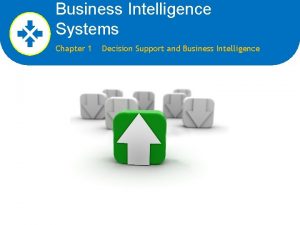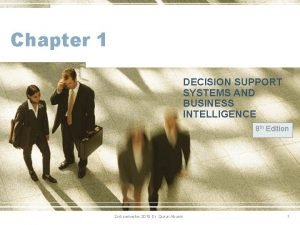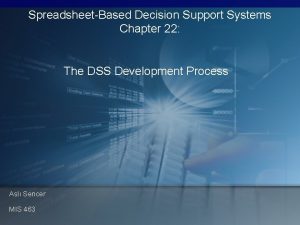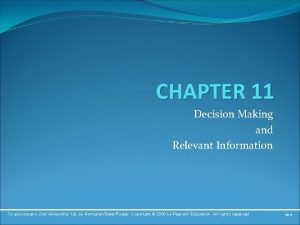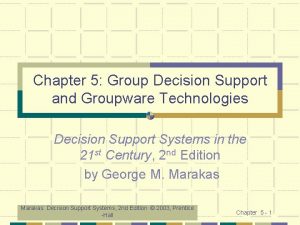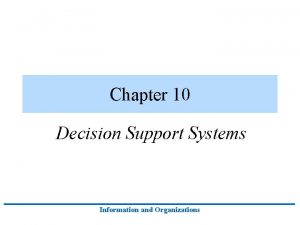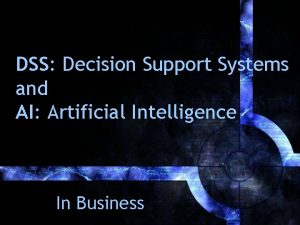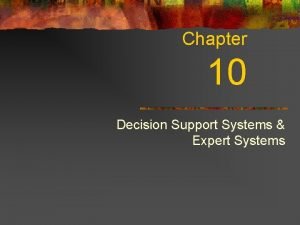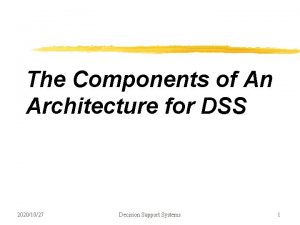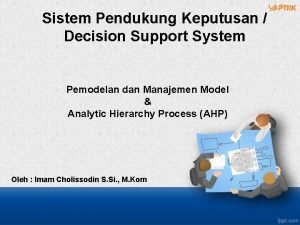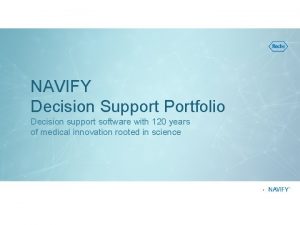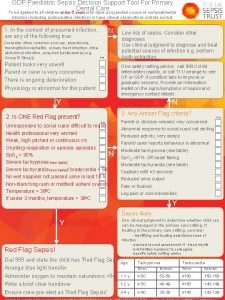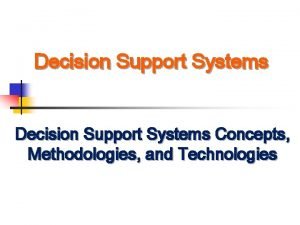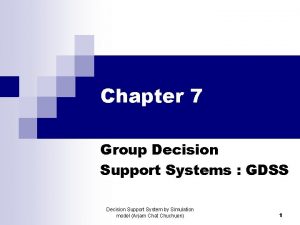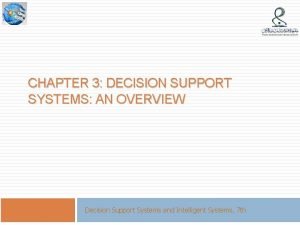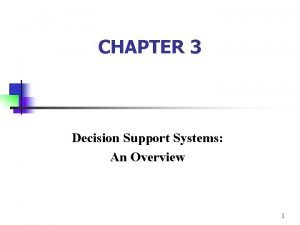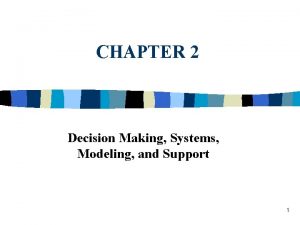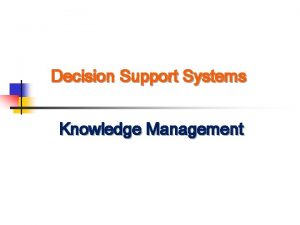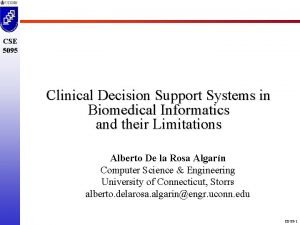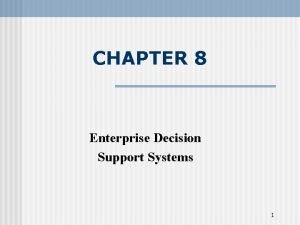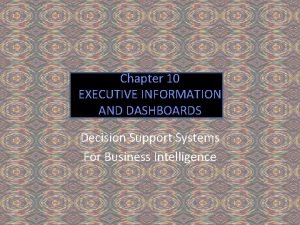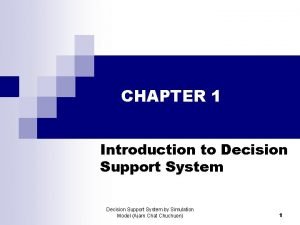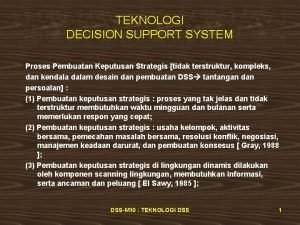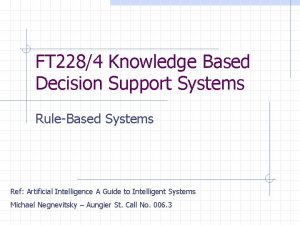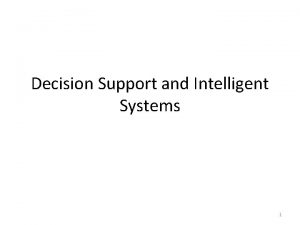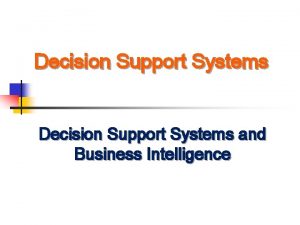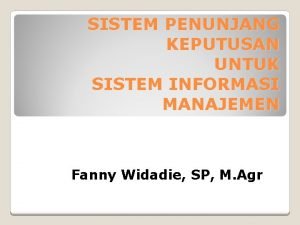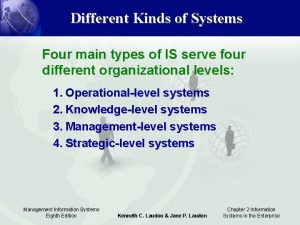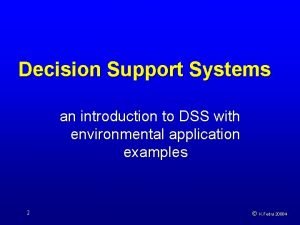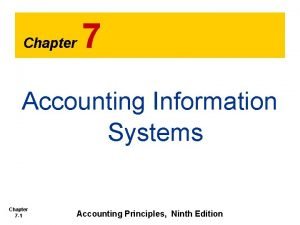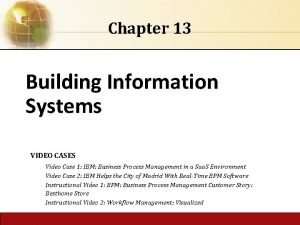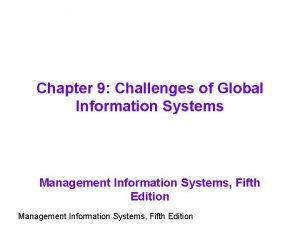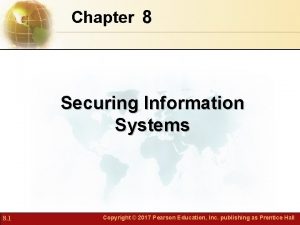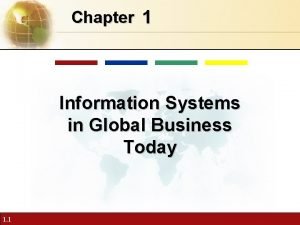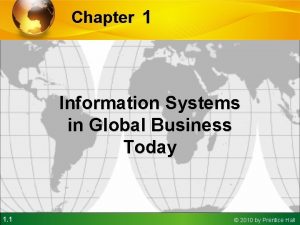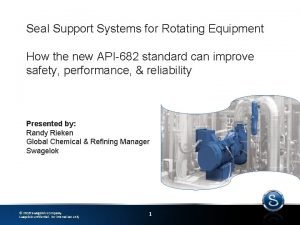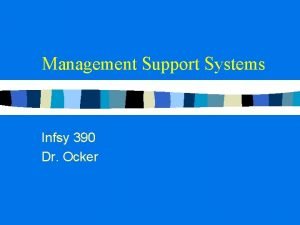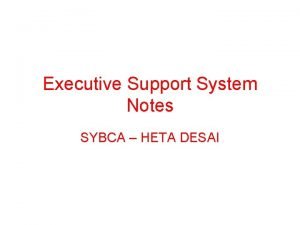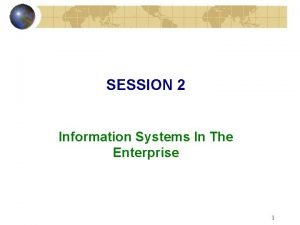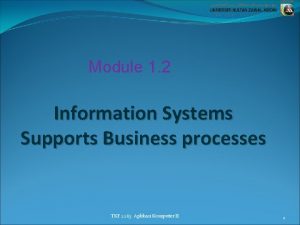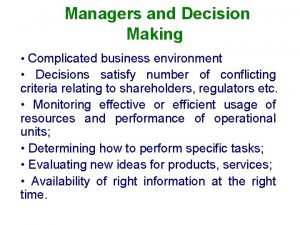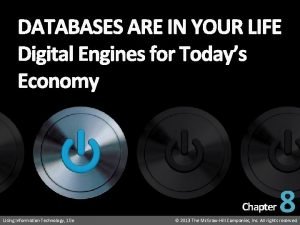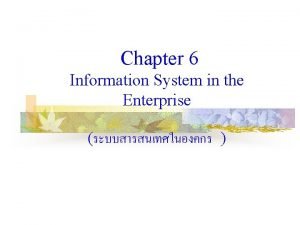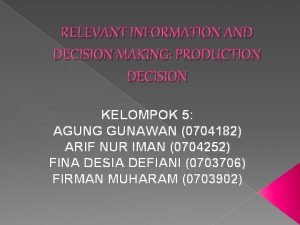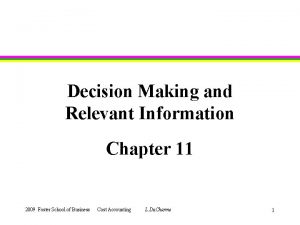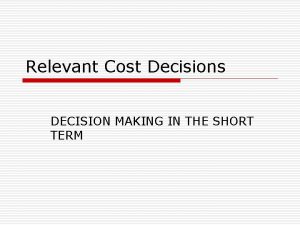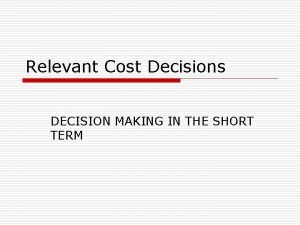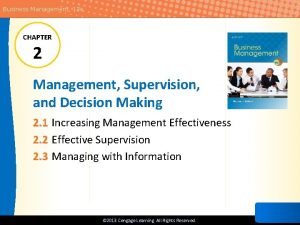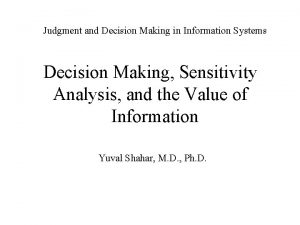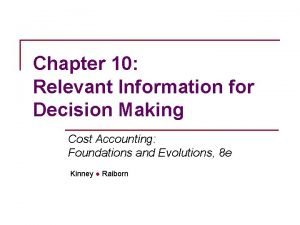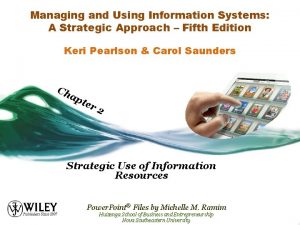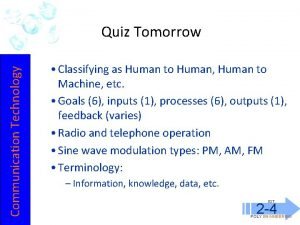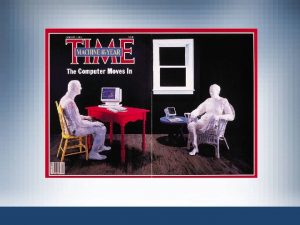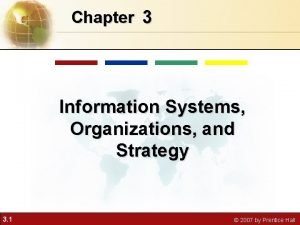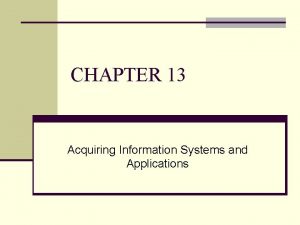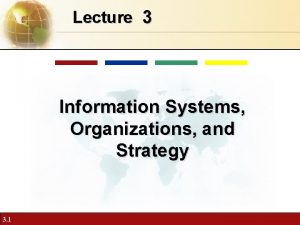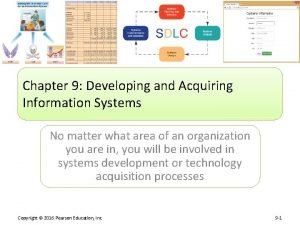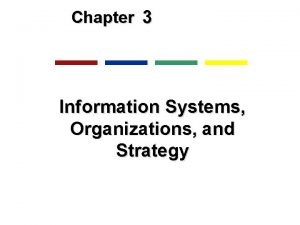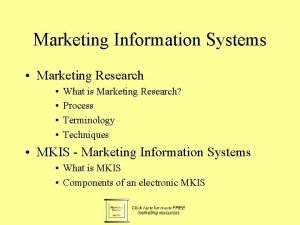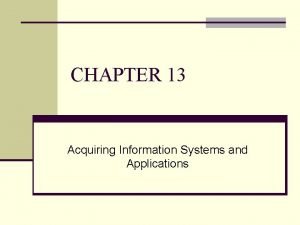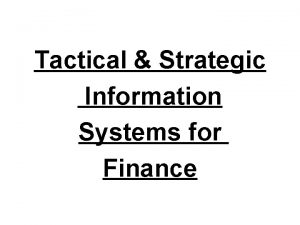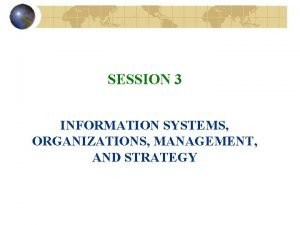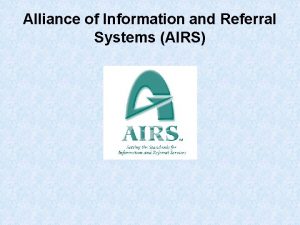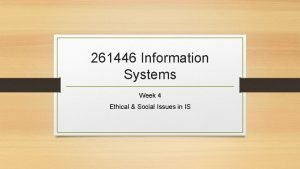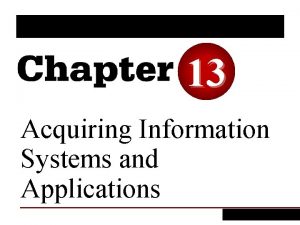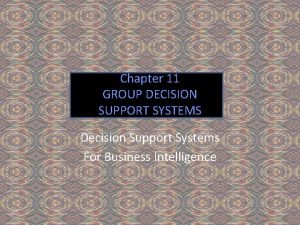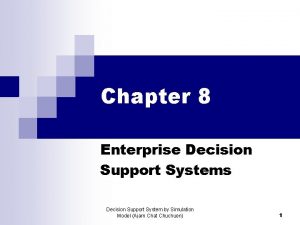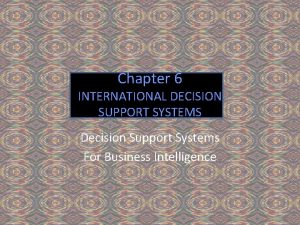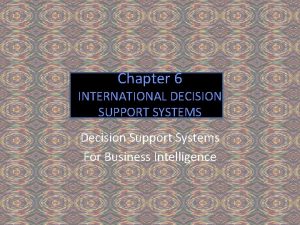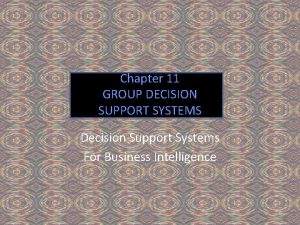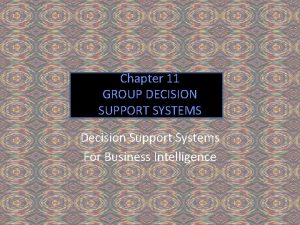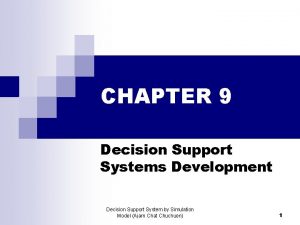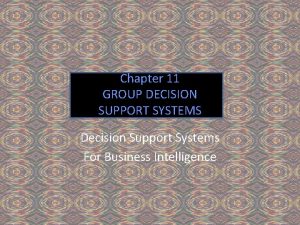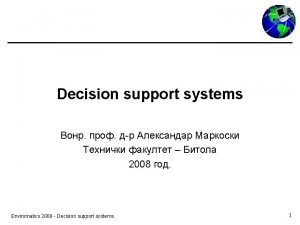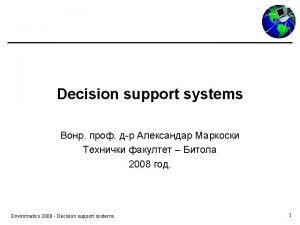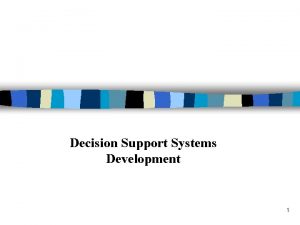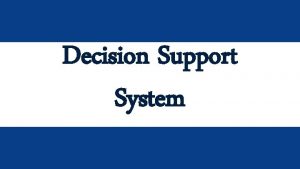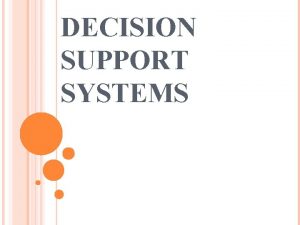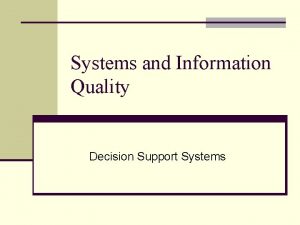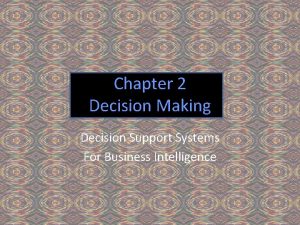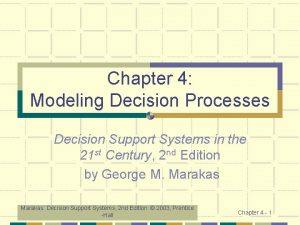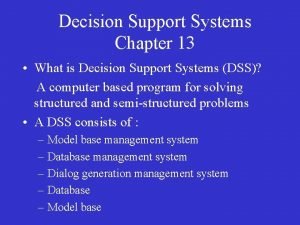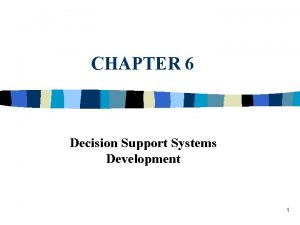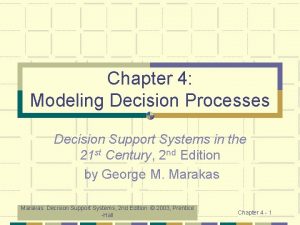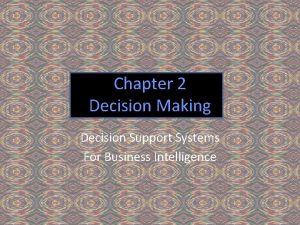Information and Decision Support Systems Chapter 10 Information


































































































































- Slides: 130

Information and Decision Support Systems Chapter 10

Information is an organization’s core asset. Transaction processing systems capture a large amount of data. Management information systems and decision support systems process and refine that data to provide vital information to decision makers and problem solvers. As organizations reengineer business processes, information systems designed for decision-making are no longer used solely by managers. To empower employees to make their own decisions and solve their own problems, organizations must provide employees at all levels of the enterprise with timely information provided by these systems. Chapter 10 Principles of Information Systems, Fifth Edition Slide 2

Chapter 10 discusses information systems used for decision-making and problem solving in business, including management information systems and decision support systems. After studying this chapter, you should be able to address the objectives on the next 3 slides. Chapter 10 Principles of Information Systems, Fifth Edition Slide 3

Learning Objectives List & describe the stages of a problemsolving process. Define “management information system” (MIS) and clearly distinguish an MIS from a TPS. Discuss information systems in the functional areas of businesses. Chapter 10 Principles of Information Systems, Fifth Edition Slide 4

Management information systems are designed to provide correct & timely information about business operations to the right person. Management information systems are explicitly designed to provide information for decision-making and problem-solving, while transaction processing systems are not. Chapter 10 Principles of Information Systems, Fifth Edition Slide 5

Learning Objectives Describe important characteristics of decision support systems (DSS) Describe the basic components of a decision support system. Chapter 10 Principles of Information Systems, Fifth Edition Slide 6

Like management information systems, decision support systems are designed to provide information to decision makers. However, decision support systems are designed to be used when problems are more unstructured. Chapter 10 Principles of Information Systems, Fifth Edition Slide 7

Learning Objectives State the goal of a group decision support system (GDSS) Identify the characteristics of a group decision support system that distinguish it from a DSS Identify basic uses of an executive support system & list its characteristics Chapter 10 Principles of Information Systems, Fifth Edition Slide 8

Group decision support systems and executive support systems extend the general approach of a DSS to specific situations, namely group and executive decision making and problem solving. Chapter 10 Principles of Information Systems, Fifth Edition Slide 9

Decision Making and Problem Solving

Before looking at the information systems designed to help decision makers and problem solvers, we should understand the decision making and problem solving processes. Chapter 10 Principles of Information Systems, Fifth Edition Slide 11

Figure 10. 1 Principles of Information Systems, Fifth Edition

As shown in Figure 10. 1, decision-making is part of problem-solving. Decision-making encompasses the first three steps of the problem-solving process: the intelligence, design and choice stages. In the intelligence stage, potential problems or opportunities are identified. Alternative solutions are developed in the design stage. And a specific solution or course of action is selected in the choice stage. Problem-solving continues with the implementation stage, where the solution is put into action. The final stage of problem-solving is monitoring, where the solution or course of action that was implemented is evaluated to see if it accomplished its goal. Principles of Information Systems, Chapter 10 Fifth Edition Slide 13

This process model doesn’t only apply to complex problems – generally people follow it in everyday decisions. For example, suppose you need to fly out of town. During the intelligence phase, you identify all the problems or issues involved. Two problems you identify are transportation to and from the airport in your hometown and your destination. In the design stage, you think of alternative ways to solve the problem. Consider transportation to your home airport. You could drive your own car and park it in long term parking. You could ask your neighbor to drive you and pick you up. You could take a cab. Or you could take the airport shuttle. Principles of Information Systems, Chapter 10 Fifth Edition Slide 14

In order to choose an option, you evaluate and each alternative – in terms of cost, convenience, and availability. Assume your neighbor offers to drive you and you chose that option. The implementation phase starts when you set up the times with him and continues when he drives you to and from the airport. Monitoring might start while you are waiting for him to pick you up – if he’s a little late, you look at your watch and start thinking about whether or not you’ll make the flight. When you check in for your flight out of town, you’re done monitoring the drive to your home airport. Chapter 10 Principles of Information Systems, Fifth Edition Slide 15

Programmed versus Nonprogrammed Decisions Programmed decisions Structured situations with well defined relationships l Quantifiable l Management information system l Chapter 10 Principles of Information Systems, Fifth Edition Slide 16

When selecting an alternative in the choice stage, various factors affect the decision. We saw in the airport transportation example that resource constraints, such as time, money, or availability, are factors. Another factor is whether the decision can be programmed. Programmed decisions are made by following rules, procedures or quantitative methods that can be described in advance and regularly used, since the situations are recurring and wellstructured. Management information systems are designed to provide information to address programmed decisions. Chapter 10 Principles of Information Systems, Fifth Edition Slide 17

Many simple programmed decisions can be completely automated – for example, inventory control systems can be programmed with reorder points and automatically trigger an order for more merchandise when the reorder point is reached. Chapter 10 Principles of Information Systems, Fifth Edition Slide 18

Programmed versus Nonprogrammed Decisions Nonprogrammed decisions Ill-structured situations with vague or changing relationships between variables l Not easily quantifiable in advance l Decision support systems l Chapter 10 Principles of Information Systems, Fifth Edition Slide 19

Nonprogrammed decisions involve unusual, continually changing, or novel circumstances and poorly structured situations. It is usually difficult or impossible to quantify nonprogrammed decisions or to develop rules or procedures to follow to solve the problem. An example of a nonprogrammable or poorly structured situation would be deciding where to locate a new regional airport. This is not a decision that is made often, and each time such a decision is made, it involves a different locale, different economic conditions, different population concerns, and so on. Chapter 10 Principles of Information Systems, Fifth Edition Slide 20

Decision support systems are designed to help decision makers with nonprogrammed or ill-structured problems. Chapter 10 Principles of Information Systems, Fifth Edition Slide 21

Problem Solving Approaches Optimization: find the best solution Satisficing: find a good solution Heuristics: use rules of thumb Chapter 10 Principles of Information Systems, Fifth Edition Slide 22

Computerized decision support systems can usually be used for both optimization and satisficing modeling. An optimization model finds the best solution in relation to the constraints, assumptions, and goals it was given. For example, an optimization model can find the optimal labor cost to produce a particular product and meet a specific level of profit, subject to the cost of raw materials and machinery. Profit level is a goal and costs are a constraint in the model. Chapter 10 Principles of Information Systems, Fifth Edition Slide 23

A satisficing model finds a good, but not necessarily the best, solution. Satisficing is used when optimization is too difficult, costly, or complex. Satisficing looks only at solutions that are likely to produce a good solution and can thus be done more easily and quickly than optimization, which involves an exhaustive search of all possible solutions. Chapter 10 Principles of Information Systems, Fifth Edition Slide 24

Heuristics, or rules of thumb, are often used in decision making. Heuristics are generally accepted guidelines, or guidelines developed through experience, that usually find a good solution. For example, you might follow a heuristic of taking an umbrella if it is cloudy, windy, and humid when you leave the house. Your experience has shown you that generally this results in having an umbrella when it rains. However, this isn’t an optimal solution – since sometimes you carry an umbrella unnecessarily and sometimes it rains on days when you don’t have an umbrella. But the cost of finding an optimal solution is far too great in terms of time and money. Chapter 10 Principles of Information Systems, Fifth Edition Slide 25

Figure 10. 2 Principles of Information Systems, Fifth Edition

Spreadsheet programs often can perform optimization. Figure 10. 2 shows Solver, an optimizing routine in Excel. Chapter 10 Principles of Information Systems, Fifth Edition Slide 27

An Overview of Management Information Systems

Management information systems provides decisionmakers information and feedback on daily operations. Additionally, management information systems can be used strategically, often incorporating Web technology. Chapter 10 Principles of Information Systems, Fifth Edition Slide 29

Figure 10. 3 Principles of Information Systems, Fifth Edition

Figure 10. 3 shows the relationship of management information systems to information sources and other organizational systems. Transaction processing systems capture and update databases that provide the largest source of input to management information systems. Input data is provided by additional internal and external databases. External data sources include those available over the Internet. Management information systems filter and process the data to output reports that help users plan, control, organize, and monitor operations more efficiently and effectively. Chapter 10 Principles of Information Systems, Fifth Edition Slide 31

Management information systems also create summary or application databases containing data that has been processed or summarized into a form useful to managers. Application databases can be queried analyzed by employees or used as input to decision support systems, expert systems, and executive support systems. Chapter 10 Principles of Information Systems, Fifth Edition Slide 32

Figure 10. 4 Principles of Information Systems, Fifth Edition

Most management information systems produce predetermined reports – that is, reports whose content has been designed and programmed in advance. These include scheduled reports, key indicator reports, demand reports, exception reports and drilldown reports. Scheduled reports are produced at regular intervals, such as hourly, daily, weekly or monthly. For example, a sales manager might get a weekly report summarizing sales by region, store, or salesperson. This allows the manager to monitor sales and follow-up on locations or people that seem to be slipping. Chapter 10 Principles of Information Systems, Fifth Edition Slide 34

Key indicator reports summarize the prior day’s critical activities to allow the user to take quick action to fix a potential problem. For instance, a report received each morning summarizing sales figures from each store would allow a sales manager to immediately follow up with stores that show slow sales. Demand reports are reports produced to give information at a manager’s request, rather than on a particular schedule. For example, on a Wednesday, the sales manager may request weekly sales to date for each store. Chapter 10 Principles of Information Systems, Fifth Edition Slide 35

Although these reports can be produced on demand, the requested information must have been identified at an earlier time and processed and stored in the application database. For example, if a company has never identified a store’s rate of sales growth as necessary information before, a manager cannot suddenly request it and except to receive it from the management information system. Exception reports are automatically produced to show a deviation from normal or from a plan. For example, each quarter the sales manager might receive an exception report listing those stores that failed to meet their sales target. Chapter 10 Principles of Information Systems, Fifth Edition Slide 36

Figure 10. 4 cont’d Principles of Information Systems, Fifth Edition

Drill-down reports start with highly summarized data and allow a user to request increasing levels of detail. For example, the sales manager may initially see a table listing monthly sales by region. If he wants more detail, he can use the mouse to click on a particular region, say the southeast, and would see a table summarizing sales in the southeast region by store. If he sees that store A has lower sales than any other, he could click on it and see sales for that store by department. He could click on a particular department to see sales by employee or by item. This helps users trace problems or superior performance to the root. Chapter 10 Principles of Information Systems, Fifth Edition Slide 38

Figure 10. 4 shows a drilldown report starting with earning summarized by quarter, drilling down to sales by product category. Chapter 10 Principles of Information Systems, Fifth Edition Slide 39

Table 10. 1 Principles of Information Systems, Fifth Edition

Table 10. 1 lists some guidelines for developing reports that can be useful. Ensuring MIS reports provide only useful and timely information and are designed for usability is important. Chapter 10 Principles of Information Systems, Fifth Edition Slide 41

Characteristics of an MIS Fixed format, standard reports Hard-copy or soft-copy reports Uses internal data User-developed reports Users must request formal reports from IS department Chapter 10 Principles of Information Systems, Fifth Edition Slide 42

As mentioned earlier, all reports from an MIS have been predetermined – that is, management information systems do not generally produce ad hoc reports, or unique reports done only once. Most recipients get the same report, although they may use it for different purposes. Output from an MIS may be printed, or hardcopy, or viewed on a screen, called soft-copy. Most output from an MIS is hard copy. The primary source of input data for an MIS is internal data stored in internal databases, generally data collected and maintained by a transaction processing system. Chapter 10 Principles of Information Systems, Fifth Edition Slide 43

Sometimes data from external databases is added, such as general economic data or data about competitors’ actions. Since an MIS create an application database, end users can request their own simple reports to access the information stored in it. However, if many users develop the same report, it may be more efficient for the IS department to produce it. More complex reports are generally requested from the IS department and developed by specialists. Chapter 10 Principles of Information Systems, Fifth Edition Slide 44

Functional Aspects of the MIS

Each management information system is an integrated collection of subsystems, often organized along functional lines of an organization. Chapter 10 Principles of Information Systems, Fifth Edition Slide 46

Figure 10. 5 Principles of Information Systems, Fifth Edition

Functional areas typically include accounting, finance, marketing, personnel, operations, research and development, and legal. Management information systems organized by functional area produce specialized reports for each area. Chapter 10 Principles of Information Systems, Fifth Edition Slide 48

Figure 10. 6 Principles of Information Systems, Fifth Edition

A financial MIS provides information to people who need to make decisions involving the company’s finances. Figure 10. 6 shows an overview of a financial information system. A financial MIS integrates financial and operational information from multiple internal and external sources and makes financial data available on a timely basis and allows funds to be monitored and controlled over time. Typically, a financial MIS provides easy access to financial data to both financial and nonfinancial users – increasingly through intranets and extranets. Chapter 10 Principles of Information Systems, Fifth Edition Slide 50

Most financial information systems allow financial data to be analyzed in a variety of ways, such as by time, customer or product line, and allow past and present financial activity to be analyzed and monitored. A financial MIS helps a company manage and use funds effectively for internal uses, such as inventory or supplies, and for external investments. Financial information systems include profit/loss and cost systems, which organize revenue and cost data. Revenue and expense data collected by the transaction processing system are a primary input to the financial MIS. Chapter 10 Principles of Information Systems, Fifth Edition Slide 51

Figure 10. 7 Principles of Information Systems, Fifth Edition

Manufacturing management information systems assist in the control and monitoring of materials, products and services through the organization. The purpose of a manufacturing MIS is to help a firm produce products or services that meet customer needs at the lowest possible cost. A manufacturing MIS includes subsystems that track raw material inventory and finished inventory, assist on the shop floor or in design and engineering, and help control production, costs and quality. Chapter 10 Principles of Information Systems, Fifth Edition Slide 53

For example, computer-added design, or CAD, programs help in product design and configuration. CAD programs can be used to develop three-dimensional product models. Chapter 10 Principles of Information Systems, Fifth Edition Slide 54

Figure 10. 8 Principles of Information Systems, Fifth Edition

Master production scheduling is part of many manufacturing information systems. A master production schedule plans both short-term and long-range production facilities scheduling. Some scheduling programs can be used to forecast demand for products or services and schedules facilities to best meet the demand. Most programs also allow a production manager to perform sensitivity analysis to see changes on the production schedule that would result from demand or cost changes. Chapter 10 Principles of Information Systems, Fifth Edition Slide 56

Manufacturing MIS Inventory management (MRP, JIT) Process control Computer-assisted manufacturing (CAM) l Computer integrated manufacturing l Flexible manufacturing system l Quality control Chapter 10 Principles of Information Systems, Fifth Edition Slide 57

Inventory control programs are one component of a manufacturing MIS that relies on the production schedule. Inventory control programs can forecast future production, automatically reorder items when a certain threshold is met, determine manufacturing costs, and develop resource requirements plans from the production schedule. Manufacturing Requirements Planning (MRP) programs help coordinate thousands of inventory items when demand for one item depends on demand for another. Chapter 10 Principles of Information Systems, Fifth Edition Slide 58

MRP systems determine when finished products are needed, then work backward to determine deadlines and resources needed to complete the final product on schedule. When high inventory levels are kept, a company’s money is tied up in unused inventory. This means higher costs for the company. A Just-in-time (JIT) inventory approach ensures inventory and materials are delivered only when they are needed. This maintains inventories at their lowest possible level, but insures materials are on-hand in time for production. Chapter 10 Principles of Information Systems, Fifth Edition Slide 59

Although JIT is beneficial, it also makes a business vulnerable to supply chain disruptions – whether internal or external. For example, if a machine breaks down that makes a component another unit needs to assemble the product, assembly may need to stop due to lack on components. Technologies have been developed to control and streamline the manufacturing process. Computers can directly control manufacturing equipment using computerassisted manufacturing software. Computer-integrated manufacturing software connects all aspects of production together, including order processing, product design, manufacturing, quality control, and shipping. Chapter 10 Principles of Information Systems, Fifth Edition Slide 60

For example, after an engineer designs a product using CAD software, MRP systems can use information from the design as input to plan and order materials. Production scheduling systems can use the design specifications as an input into the scheduling process. And computer-added manufacturing systems can use the design specifications as input for setup. This greatly improves manufacturing efficiency. A flexible manufacturing system allows a facility to quickly and efficiently change from making one product to making another, often using robotics and other automation. Generally the changeover is computercontrolled. Chapter 10 Principles of Information Systems, Fifth Edition Slide 61

Finally, quality control has become paramount for manufacturing firms. Control charts or sample testing is used to monitor product quality. Chapter 10 Principles of Information Systems, Fifth Edition Slide 62

Figure 10. 9 Principles of Information Systems, Fifth Edition

Developing control charts and sampling plans can be difficult. Quality control software handles the complexity of this task. The information provided by quality control programs can help locate equipment products or design better products. Chapter 10 Principles of Information Systems, Fifth Edition Slide 64

Figure 10. 10 Principles of Information Systems, Fifth Edition

A marketing MIS includes subsystems that support the management of product development, distribution, pricing, promotion, and sales forecasting in order to increase sales, reduce marketing costs, and plan new products. Subsystems include marketing research, product development, promotion and advertising, and product pricing. Marketing research involves conducting a formal study of the market and customer preferences. Marketing research can identify potential customers, as well as features and qualities, such as price, function or color, customers want in a particular product or service. Chapter 10 Principles of Information Systems, Fifth Edition Slide 66

Data is collected by various means, such as surveys and interviews. The Internet provides a convenient, low-cost tool to gather market research – from formal on-line surveys to chat rooms. Chapter 10 Principles of Information Systems, Fifth Edition Slide 67

Figure 10. 11 Principles of Information Systems, Fifth Edition

Product pricing is one of the complex functions that software can help with. Product pricing starts with an analysis of the demand curve for a product, which shows the relationship between price and sales. Generally, a company wants to find a price that will maximize revenues. Software makes it very easy to see relationships between price and sales, enabling quick adaptation of pricing strategies to meet market needs, and thus, increase profitability. Chapter 10 Principles of Information Systems, Fifth Edition Slide 69

Figure 10. 12 Principles of Information Systems, Fifth Edition

Sales analysis is also used to identify which products, personnel, and customers contribute to profits and which do not. Figure 10. 12 shows examples of reports that can be produced to help make sound marketing decisions. This first report shows which products are doing well, the second allows unproductive sales people to be identified, and the last show who the best customers are. Chapter 10 Principles of Information Systems, Fifth Edition Slide 71

Figure 10. 13 Principles of Information Systems, Fifth Edition

A human resource, or personnel, MIS addresses activities related to employees and potential employees. Some of the subsystems of a personnel MIS handle workforce analysis, hiring, training, and job management. Figure 10. 13 shows some of the inputs and outputs of a personnel MIS. A fundamental function of a human resource MIS is to determine the right number and kind of employees needed to do specific jobs. Chapter 10 Principles of Information Systems, Fifth Edition Slide 73

For companies involved with large projects, this can be a large and complex task, involving forecasting and project management software to determine when particular types of employees are needed and in what quantity in order to meet specific deadlines. Complex scheduling of people and jobs can be streamlined by using software. Personnel applications may also be used to schedule interviews or recruiting trips or to administer skill tests to job candidates. Often interview and test results can be analyzed and reported on by the software. Many companies now use the Internet to initially screen job candidates. Chapter 10 Principles of Information Systems, Fifth Edition Slide 74

Self-paced training in specific or general skills, or in company policies and procedures, can be done by computer-based tutorials or distance learning. Skills and proficiency tests can be administered by computer. Wage and salary administration is an important MIS subsystem. Wages, salaries and benefits can be determined, administered, and monitored using human resource information systems. Chapter 10 Principles of Information Systems, Fifth Edition Slide 75

Other Management Information Systems Accounting management information systems Geographic information systems (GIS) Chapter 10 Principles of Information Systems, Fifth Edition Slide 76

There are many other kinds of management information systems used in organizations, including accounting MISs and geographic information systems. While an organization’s transaction processing system captures accounting data, the accounting MIS provides summary information on various aspects of the accounting system, such as accounts payable or accounts receivable. A geographic information system can collect, store, manipulate and display geographic information. In a geographic information system, data are displayed according to their locations. Chapter 10 Principles of Information Systems, Fifth Edition Slide 77

Has a sales clerk ever asked you for your zip code as you pay for a product? When a retail store or restaurant chain is considering opening a new location, they may use a geographic information system to determine where their potential customers are located. By displaying a map, with zip codes color coded to show the number of customers traveling to the current store location, a business can place the new store close to the area where most of them live. Chapter 10 Principles of Information Systems, Fifth Edition Slide 78

An Overview of Decision Support Systems

Decisions support systems are people, procedures, software, databases, and devices that are used in problem-specific decision-making and problem-solving. Decision support systems are particularly useful when dealing with semi-structured, poorly structured, or unstructured situations. Although decision support systems are used most often at higher levels of management, all employees may use them to assist in even programmable decisions. Chapter 10 Principles of Information Systems, Fifth Edition Slide 80

Characteristics of Decision Support Systems Handle lots of data from various sources Report & presentation flexibility Text and graphics capabilities Support drill down analysis Chapter 10 Principles of Information Systems, Fifth Edition Slide 81

Not all decision support systems, or DSSs, are alike – some are very small in scope, with only a few of the following attributes; others are comprehensive and powerful. A DSS can analyze information stored in a data warehouse or a database that is distributed across multiple locations. External sources of data, such as those available via the Internet, can also be incorporated into a decision model. Users can see their output in an appropriate format – whether that is a chart, image, table or even map – on a printout or on the screen. In some systems, managers can also drilldown to more detailed data. Chapter 10 Principles of Information Systems, Fifth Edition Slide 82

Characteristics of a DSS Complex analysis, statistics, and forecasting Optimization, satisficing, heuristics Simulation l What-if analysis l Goal-seeking analysis l Chapter 10 Principles of Information Systems, Fifth Edition Slide 83

Many of a DSS’s analytical programs are standalone programs, integrated by the DSS. Decision support systems often support all types of decision-making approaches to allow the user great flexibility. For example, even simple spreadsheets support “what-if analysis”, which allows the user to make changes to input variables to see the result on outcomes. For example, if you can increase production either by adding a new machine or upgrading different combinations of existing machines, you can change the appropriate costs and capacities on a spreadsheet and see which increases output the most and/or costs the least. Chapter 10 Principles of Information Systems, Fifth Edition Slide 84

Simulation allows a user to model a problem by duplicating features of a real system. This generally involves some uncertainty or probability. For instance, perhaps we can increase production by either adding a new machine or by adding additional employees to set up and reconfigure existing machines between production runs. A simulation would model the complex interaction of all these variables, based on estimates of how long it takes one person to reconfigure a machine and how additional people change the time, production time of one machine, and so on. Chapter 10 Principles of Information Systems, Fifth Edition Slide 85

Figure 10. 14 Principles of Information Systems, Fifth Edition

Goal-seeking analysis is the process of determining the inputs, or variable values or quantities, needed to get a specific result. Say you want to increase production by exactly 500 units. Using goal-seeking analysis, you could find the number of additional workers you would need to add to the assembly line. Chapter 10 Principles of Information Systems, Fifth Edition Slide 87

Capabilities of a DSS Support all problem-solving phases Support different decision frequencies Support different problem structures Support various decision-making levels Chapter 10 Principles of Information Systems, Fifth Edition Slide 88

Although a specific DSS might only support one or a few phases, decision support systems can support decision makers in all the phases of the problem-solving process – that is, in the intelligence, design, choice, implementation, and monitoring stages. As we’ve seen in this chapter, decisions can range from one-of-a kind to recurring. An ad hoc DSS is useful for one-of-a kind or less structured decisions, while an institutional DSS handles situations that happen on an ongoing basis. Institutional DSSs are refined over time. Chapter 10 Principles of Information Systems, Fifth Edition Slide 89

For instance, deciding where to locate a regional airport is likely a one of a kind decision, whereas investment decisions are recurring. Thus, a DSS can support decisions ranging from unstructured to structured. Chapter 10 Principles of Information Systems, Fifth Edition Slide 90

Figure 10. 15 Principles of Information Systems, Fifth Edition

Because of their flexibility, decision support systems are useful at all levels of the organization. Chapter 10 Principles of Information Systems, Fifth Edition Slide 92

Table 10. 2 Principles of Information Systems, Fifth Edition

Table 10. 2 shows examples of decision support systems, showing the range of support they can provide. Chapter 10 Principles of Information Systems, Fifth Edition Slide 94

Table 10. 3 Principles of Information Systems, Fifth Edition

Decision support systems differ from management information systems in many ways. We’ve seen that an MIS designed to support structured decisions, whereas a DSS can handle structured and less structured situations. Users are more actively involved in the creation and use of decision support systems than management information systems. Table 10. 3 describe these and other differences. Chapter 10 Principles of Information Systems, Fifth Edition Slide 96

Components of a DSS

Decision support systems are composed of several interrelated parts. Chapter 10 Principles of Information Systems, Fifth Edition Slide 98

Figure 10. 16 Principles of Information Systems, Fifth Edition

A database and model base are at the heart of a DSS, but many also allow external database and Internet access. Additionally, a DSS has an easy to use interface, called a dialogue manager. For example, the dialog manager for a spreadsheet programs such as Excel, is an interactive worksheet with easy to use menus. Chapter 10 Principles of Information Systems, Fifth Edition Slide 100

The Model Base Financial models Cash flow l Internal rate of return l Statistical analysis models Averages, standard deviations l Correlations l Regression analysis l Chapter 10 Principles of Information Systems, Fifth Edition Slide 101

Decision makers use a DSS to model problems or situations in various ways. For instance, financial models can show the relationship among variable in investment analysis. The model base gives DSS users access to a variety of built-in models they can use, so users don’t need to write lengthy programs to create their own models. Often, model management software coordinates the use of models in a DSS. For example, consider the examples of financial models listed on the slide. Chapter 10 Principles of Information Systems, Fifth Edition Slide 102

Rather than a decision-maker trying to remember how to calculate the internal rate of return for an investment and then figure out how to enter commands for the DSS to perform the calculations, it is far more efficient to use the built in internal rate of return model. Although some businesses create complex financial models unique to their situation, DSS software contains powerful financial models. Chapter 10 Principles of Information Systems, Fifth Edition Slide 103

Statistical models perform many tasks, including summary statistics, trends, and hypothesis testing. Although there are powerful software packages dedicated to statistical modeling, such as SPSS and SAS, today’s spreadsheets contain a large set of statistical analysis models. Chapter 10 Principles of Information Systems, Fifth Edition Slide 104

The Model Base Graphical models Project management models Chapter 10 Principles of Information Systems, Fifth Edition Slide 105

Graphical modeling tools help decision makers develop and use graphic displays of data and information. Although simple graphic modeling tools exist, such as Power. Point or Visio, there also sophisticated, highend tools, such as computer-assisted design (CAD) software. Project management models are used to coordinate and control projects and identify critical activities or tasks that could delay a project if not completed on time. Chapter 10 Principles of Information Systems, Fifth Edition Slide 106

Group Decision Support Systems

Although decision support systems help individuals make better decisions, many business decisions are made by groups. Higher level managers often spend more than half their decision-making time in meetings. Group decision support systems, also called group support systems or computerized collaborative work systems, are designed to support group decision making. Some types of GDSS software, called groupware or workgroup software, help with group scheduling, communications, and management. Lotus Notes and Microsoft Exchange are examples of such software. Chapter 10 Principles of Information Systems, Fifth Edition Slide 108

Figure 10. 17 Principles of Information Systems, Fifth Edition

A group decision support system, or GDSS, contains most of the same components as a DSS, plus GDSS software to support communications between group members. Chapter 10 Principles of Information Systems, Fifth Edition Slide 110

Characteristics of a GDSS Special design Ease of use Flexibility Decision-making support Chapter 10 Principles of Information Systems, Fifth Edition Slide 111

GDSSs are designed to support effective group communication and good decision making techniques, as well as creative thinking. As a general rule, any software that is hard to use, won’t be used. GDSS software must be especially user friendly, since often groups have less patience with bad software than do individuals. Since different people may solve the same problem in different ways, a GDSS should support different approaches to decision-making, as well as integrate their output into a common view. Chapter 10 Principles of Information Systems, Fifth Edition Slide 112

A GDSS supports group decision-making techniques, such as the Delphi approach, brainstorming, group consensus, and the nominal group technique. Chapter 10 Principles of Information Systems, Fifth Edition Slide 113

Characteristics of a GDSS Anonymous input Reduction of negative group behavior Parallel communication Automated record keeping Chapter 10 Principles of Information Systems, Fifth Edition Slide 114

Many GDSSs allow anonymous input, where group members cannot identify who provided the input. This allows people to focus on the merits of the input without considering its source. Sometimes, one or two individuals take over a group discussion, preventing input from other members, or a group member sidetracks the group into an unrelated or nonproductive area. Another negative group effect is called groupthink – a group thinks it has made the right decision because all agree on it, without examining alternatives. For these reasons, many traditional meetings are unproductive. Chapter 10 Principles of Information Systems, Fifth Edition Slide 115

GDSS designers try to design software that reduces this kind of problem by including procedures for effectively planning and managing meetings into the software. Often a trained facilitator leading a GDSS meeting also helps avoid such problems. In traditional meetings, only one person speaks at a time. More timid members may never speak up, or a person may have forgotten what he was going to say by the time the current speaker is finished. Chapter 10 Principles of Information Systems, Fifth Edition Slide 116

Using GDSS software, all participants can type comments at the same time and read everyone’s comments displayed on their monitor. This can also keep meetings shorter. GDSSs can store each anonymous comment, as well as voting results. Chapter 10 Principles of Information Systems, Fifth Edition Slide 117

Figure 10. 18 Principles of Information Systems, Fifth Edition

A GDSS can be configured in a number of ways, depending on the needs of the group, the location of participants, and frequency of the decision. Figure 10. 18 classifies alternatives by decision frequency and the location of participants. When group members are in the same location and group decision making is frequent, group support software is placed in individual offices and participants communicate over a LAN. Software such as Microsoft’s Net. Meeting allows participants to take control of the mouse and work on a shared application while other watch. Software such as Lotus Notes can be used to share ideas and documents. Chapter 10 Principles of Information Systems, Fifth Edition Slide 119

When decision frequency is low and participants are geographically dispersed, teleconferencing is often the appropriate alternative. Teleconferencing can be used to connect individuals or GDSS decision rooms using long distance telecommunications technology. A wide area decision network is appropriate for high frequency decisions made by people who are scattered geographically. A decision room is appropriate when participants are located in the same place and occasionally use the GDSS for decisions. Chapter 10 Principles of Information Systems, Fifth Edition Slide 120

Figure 10. 19 Principles of Information Systems, Fifth Edition

A decision room combines face-to-face interaction and GDSS technology. Figure 10. 19 shows a typical decision room layout. Chapter 10 Principles of Information Systems, Fifth Edition Slide 122

Executive Support Systems

Executive support systems, or executive information systems, were developed to provide senior managers the type of information they need, in the format they need it. Executive support systems include a DSS, as well as other tools, such as office automation. Chapter 10 Principles of Information Systems, Fifth Edition Slide 124

Figure 10. 20 Principles of Information Systems, Fifth Edition

Figure 10. 20 shows the top layers of management that executive support systems were originally designed for. Today, their use is not restricted to top management, since many organizations have reengineered business processes and given employees more decision-making authority. Chapter 10 Principles of Information Systems, Fifth Edition Slide 126

Executive Support Systems (ESS) in Perspective Tailored to individual executives Easy to use Drill down capabilities Access to external data Can help when uncertainty is high Future-oriented Linked to value-added processes. Chapter 10 Principles of Information Systems, Fifth Edition Slide 127

Although executive support systems have much in common with decision support systems, they have important differences. Generally, a DSS provides a number of modeling tools and is designed to help a user answer a question. Executive support systems allow executives to ask the right questions. An ESS is interactive and helps an executive focus, filter and organize data and information. Unlike a DSS, an ESS is usually customized for a specific individual. Content and format can both be customized. Since executives are typically busy, an ESS must be easy to learn and to use – or it won’t be used. Chapter 10 Principles of Information Systems, Fifth Edition Slide 128

Capabilities of an ESS Support for defining an overall vision Support for strategic planning Support for strategic organizing & staffing Support for strategic control Support for crisis management Chapter 10 Principles of Information Systems, Fifth Edition Slide 129

Most executive support systems are designed to give the user a top-down view of business processes and allow him to drill down to greater levels of detail. This capability, as well as access to external databases and to DSS modeling tools, allows top-level managers to work on long term, strategic issues that affect the whole company. Chapter 10 Principles of Information Systems, Fifth Edition Slide 130
 Decision support systems and intelligent systems
Decision support systems and intelligent systems Objectives of decision making
Objectives of decision making Dividend decision in financial management
Dividend decision in financial management Decision support and business intelligence systems
Decision support and business intelligence systems Decision support and business intelligence systems
Decision support and business intelligence systems Expert system in dss
Expert system in dss Developing spreadsheet-based decision support systems
Developing spreadsheet-based decision support systems Chapter 2 economic systems and decision making answer key
Chapter 2 economic systems and decision making answer key Chapter 2 economic systems and decision making
Chapter 2 economic systems and decision making Chapter 2 economic systems and decision making answer key
Chapter 2 economic systems and decision making answer key How do information systems aid in decision making
How do information systems aid in decision making Decision table and decision tree examples
Decision table and decision tree examples Five step decision making process
Five step decision making process Chapter 11 decision making and relevant information
Chapter 11 decision making and relevant information Relevant information for decision making
Relevant information for decision making Mdm support technologies in dss
Mdm support technologies in dss Local area decision network
Local area decision network Difference between dss and expert system
Difference between dss and expert system Expert system and decision support system
Expert system and decision support system What are signal words
What are signal words Types of information systems
Types of information systems Architecture of dss
Architecture of dss Contoh spk motor honda
Contoh spk motor honda Navify decision support
Navify decision support Gdp sepsis decision support tool
Gdp sepsis decision support tool Components of decision support system
Components of decision support system Components of group decision support system
Components of group decision support system Characteristics of a decision support system
Characteristics of a decision support system Components of decision support system
Components of decision support system Systematic decision making process
Systematic decision making process Model driven decision support system
Model driven decision support system Decision support system in knowledge management
Decision support system in knowledge management Iliad clinical decision support system
Iliad clinical decision support system Enterprise decision support system
Enterprise decision support system Objectives of dss
Objectives of dss Chapter 10
Chapter 10 Evolution of dss
Evolution of dss Proses decision support system
Proses decision support system Knowledge based decision support system
Knowledge based decision support system Benefits of decision support system
Benefits of decision support system Marketing decision support system
Marketing decision support system Types of information systems in an organization
Types of information systems in an organization Dss business intelligence
Dss business intelligence Operational data vs decision support data
Operational data vs decision support data Business intelligence trends 2011
Business intelligence trends 2011 Voyage estimating decision support system
Voyage estimating decision support system Maintenance decision support system
Maintenance decision support system Isabel clinical decision support
Isabel clinical decision support Essentials of management information systems
Essentials of management information systems Types of information systems
Types of information systems Wildland fire decision support system
Wildland fire decision support system Introduction to decision support system
Introduction to decision support system Chapter 4 ethical issues
Chapter 4 ethical issues Chapter 4 ethical and social issues in information systems
Chapter 4 ethical and social issues in information systems Chapter 3 information systems organizations and strategy
Chapter 3 information systems organizations and strategy Function of information system with diagram
Function of information system with diagram Chapter 8 securing information systems
Chapter 8 securing information systems Chapter 8 securing information systems
Chapter 8 securing information systems Chapter 7 accounting information systems
Chapter 7 accounting information systems Chapter 7 accounting information systems
Chapter 7 accounting information systems Chapter 13 building information systems
Chapter 13 building information systems Securing information systems
Securing information systems White-collar workers คือ
White-collar workers คือ Fundamentals of information systems chapter 1
Fundamentals of information systems chapter 1 Challenges of global information systems
Challenges of global information systems Chapter 8 securing information systems
Chapter 8 securing information systems Chapter 1 information systems in global business today
Chapter 1 information systems in global business today Mis chapter 1
Mis chapter 1 Chapter 8 securing information systems
Chapter 8 securing information systems Chapter 7 accounting information systems
Chapter 7 accounting information systems Information systems in global business today
Information systems in global business today Seal support system
Seal support system Management support system
Management support system Sybca
Sybca Eolss
Eolss Managerial support systems
Managerial support systems Executive support systems
Executive support systems Executive support systems
Executive support systems What is mis in computer
What is mis in computer Executive support systems
Executive support systems Executive support systems
Executive support systems Executive support systems
Executive support systems Professional support systems
Professional support systems Unit 5 p7
Unit 5 p7 Decision making and relevant information
Decision making and relevant information Decision making and relevant information
Decision making and relevant information Decision making and relevant information
Decision making and relevant information Decision making and relevant information
Decision making and relevant information Chapter 6 prices and decision making assessment answers
Chapter 6 prices and decision making assessment answers Management chapter 5 planning and decision making
Management chapter 5 planning and decision making Chapter 2 management supervision and decision making
Chapter 2 management supervision and decision making Options-based planning
Options-based planning Chapter 1 section 3 economic choices and decision making
Chapter 1 section 3 economic choices and decision making Chapter 34 protection support and locomotion
Chapter 34 protection support and locomotion Chapter 24 nutritional care and support
Chapter 24 nutritional care and support Chapter 28 nutritional support and iv therapy
Chapter 28 nutritional support and iv therapy Chapter 28 nutritional support and iv therapy
Chapter 28 nutritional support and iv therapy Chapter 28 nutritional support and iv therapy
Chapter 28 nutritional support and iv therapy Chapter 33: protection, support, and movement answers
Chapter 33: protection, support, and movement answers Chapter 2 camera handling care and support
Chapter 2 camera handling care and support Chapter 24 the immune and lymphatic systems and cancer
Chapter 24 the immune and lymphatic systems and cancer What empties into the left subclavian vein
What empties into the left subclavian vein Value of information in decision making
Value of information in decision making Information approach to decision usefulness
Information approach to decision usefulness Information theory decision tree
Information theory decision tree Relevant information for decision making
Relevant information for decision making Engineering elegant systems: theory of systems engineering
Engineering elegant systems: theory of systems engineering Embedded systems vs cyber physical systems
Embedded systems vs cyber physical systems Elegant systems
Elegant systems Managing and using information systems
Managing and using information systems Social issues in mis
Social issues in mis Information systems and communication technologies quiz
Information systems and communication technologies quiz Ethical and social issues in information systems doc
Ethical and social issues in information systems doc Knowledge management and specialized information systems
Knowledge management and specialized information systems Information systems, organizations, and strategy
Information systems, organizations, and strategy Acquiring information systems
Acquiring information systems Information systems, organizations, and strategy
Information systems, organizations, and strategy Acquiring information examples
Acquiring information examples Information systems, organizations, and strategy
Information systems, organizations, and strategy Finer segmentation
Finer segmentation Marketing information systems and marketing research
Marketing information systems and marketing research Marketing information systems and marketing research
Marketing information systems and marketing research Marketing information systems and marketing research
Marketing information systems and marketing research Marketing information system kotler
Marketing information system kotler Marketing information systems and marketing research
Marketing information systems and marketing research Acquiring information systems and applications
Acquiring information systems and applications Tactical accounting and financial information systems
Tactical accounting and financial information systems Information systems organizations and strategy
Information systems organizations and strategy Airs certification
Airs certification Ethical and social issues in information systems
Ethical and social issues in information systems Acquiring information systems and applications
Acquiring information systems and applications



